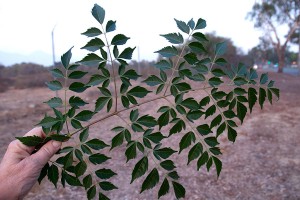
Two clumps of Chinaberries growing in the Foothill Blvd parkway. (The young trees behind them with lighter green leaves are Trees-of-Heaven). ©Nancy Hamlett.
A new plant invader has been spotted at the BFS – Melia azedarach. This tree is commonly known as Chinaberry, but also has many other common names, including Texas Umbrella Tree, Persian Lilac, White Cedar, Bead-Tree, Cape lilac, Ceylon Cedar, and Pride of India. Several sprouting clumps of M. azedarach growing in the Foothill Blvd parkway with Ailanthus altissima (Tree-of-Heaven), were removed by volunteers last Saturday.
This member of the mahogany family (Meliaceae) is a fast-growing tree (reaching heights of up to 50 ft) that is native to temperate and tropical Asia (China, Japan, India, Sri Lanka, Indonesia, Papua New Guinea), Australia, and the Solomon Islands. It was introduced as an ornamental into Charleston, South Carolina, around 1830 and is now naturalized throughout the southern half of the US.
M. azedarach has large (up to 2 ft long), doubly compound alternate leaves on long petioles. The leaflets are dark green above and lighter green below, with serrate (saw-toothed) margins.
The Chinaberry tree has all the hallmarks of an invasive species. It has few predators outside of its native habitat and requires little water. Its huge numbers of fruits attract birds, who disperse the seeds over large distances, and it also sprouts from stumps and roots (especially if the plants are injured or cut) to form dense thickets that crowd out native vegetation. Its leaf litter changes the soil chemistry – increasing the pH and the nitrogen content, and the leaves and roots release compounds that inhibit the germination and growth of other plant species (allelopathy).
Although M. azedarach primarily colonizes disturbed areas, some invasion of intact habitat has been reported in Texas and Florida. It has not yet been listed as invasive by the California Invasive Plant Council, but it is listed as invasive the National Park Service, the Florida Exotic Pest Plant Council, and Texas Invasive Plant & Pest Council.
We hope we have removed all the Chinaberry trees, but if you spot any at the BFS, please report them to the Director, Wallace Meyer (Wallace.Meyer@Pomona.edu).
More information:
- Waggy, Melissa, A. 2009. Melia azedarach. In: Fire Effects Information System, [Online]. U.S. Department of Agriculture, Forest Service, Rocky Mountain Research Station, Fire Sciences Laboratory. http://www.fs.fed.us/database/feis/
- Plant Conservation Alliance, Alien Plant Working Group. 2009. Chinaberry (Melia azedarach) – Fact Sheet. http://www.nps.gov/plants/alien/fact/meaz1.htm
- Florida Exotic Pest Plant Council. 2011. Melia azederach L. http://www.fleppc.org/ID_book/melia%20azederach.pdf (PDF)
- Texas Invasive Plant & Pest Council. 2004. Melia azedarach (Chinaberry tree). http://www.texasinvasives.org/plant_database/detail.php?symbol=MEAZ
